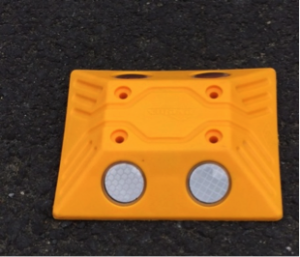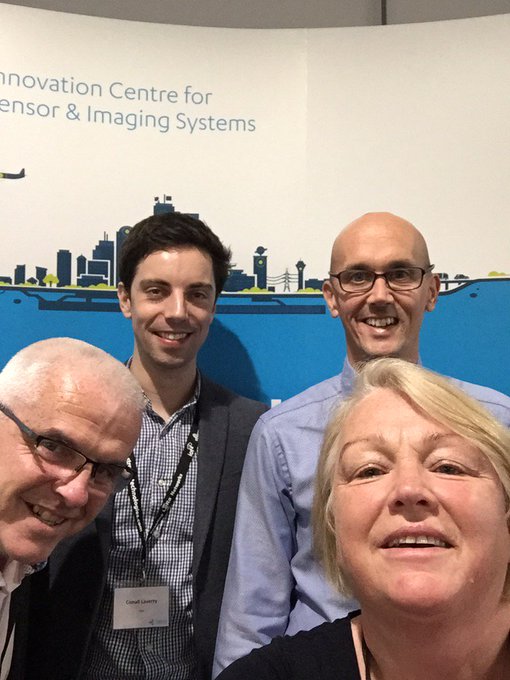So we were challenged. I had been watching the CENSIS Innovation Group in Glasgow since meeting one of its engineers, Stuart Simpson, at an NMI event. I really liked what they were doing, supporting research in Scotland and helping ideas get connected into industry. When I saw that they were running an IoT Conference, I really wanted Mint Tek Circuits to be part of it. But, when I got in touch re exhibiting this was the reply I got:

Siobhán ni ni Chofaigh, CEO and Founder of Mint Tek Circuits, discusses how an enquiry about exhibiting at a conference lead to an exciting new project development.
Hi Siobhan
Thanks for your email and your interest in our Tech Summit.
We’re looking for companies this year with hands-on technology to demonstrate that is connected to one of the three technical themes; the connected self (e.g., wearable devices), the connected community (examples of distributed networks of sensors and how they impact on things like smart cities, transport, environmental monitoring etc.) or the connected businesses (examples of businesses using IoT/connected networks to introduce new services or processes). If Mint Tek fits in to one or more of these areas, we’d love to see you apply.
Best wishes
Sian, Business Development Manager
My challenge was this – Mint Tek Circuits enable people to create prototypes and devices. We free up developers’ time by creating a platform where they can securely source the build of their prototypes. We don’t design new products or embed new ideas we deliver the building blocks for their ideas.
I realised that I needed help and I knew the man to call. John O’Connell of CW Applied Technology has been developing and building products for his customers for many years. Needless, to say John came up trumps he had an idea he was mulling around in his head. This was the opportunity to bring it to life.
John and I are hardware people, this product needed to get to into the cloud and it needed it quickly. I had met Conall Laverty from WIA Technologies. WIA are a fast moving startup building IoT Stacks that can be quickly implemented and used by start-ups and Enterprise. The team was ready.
This case study will outline the steps taken to build an IoT device from an existing design of an ‘unconnected’ device.
Basically, we will create a product using normal design – PCB, BOM, Stencil & Assembly, and working with the off the shelf WIA solution connect it to the ‘cloud’ and IoT enable.
We have a number of designs at concept stage and will fully document and explain the process showing time spent, costs and learnings.
Hardware design & build:
- Time : 6 Weeks
- People: 2 engineers (30%)
Hardware prototype cost:
- Number of Prototypes 10
- PCB … €200
- Assembly €1,000
- Housing €200
Software evaluation
Software needs evaluation: Enrol 1 device on Lora RF device cloud platform
- Time 0.5 days
- People: 1
Software decision to outsource:
CW is a hardware company. It would take 2-3 weeks full time engineer to build platform. Or hire a software engineer.
Embedding Software process
- Enrol 10 devices on the platform.
- Use Python to script data transfer from sensors.
- Use webserver to evaluate information – HTML & PHP
- Languages: Python, HTML, PHP
- Time: 10 working days
- People: 1 engineer
- Problems: Easily resolved as platform was set up for task.
- Conflicts: None
Final Costs
- Hardware: €1,400
- Software: €0.00
- People: €10,720
- (20 days for H/W, 10 days for S/W, 0.5 days for evaluation, 3 Days for purchasing). 33.5 days @€320 per day
- Time: 33.5 working days
Results
- 10 fully functioning devices, with graphical I/F for testing, demonstration.
- Full NPI report and DFM on hardware
- Full embedded Software evaluation.
Reaction
Across is the finished module built using existing road surface housings. The speed and the time at which a fully functioning car park sensoring project was created and demoed was commented on. The consensus was that a similar project in a company would take 60 + days and cost about €15,000.
Using the expertise of the three companies reduced costs but more importantly created a working system and a blueprint for volume production.
By ensuring that all exhibitors displayed relevant technologies and case studies the attendees were more engaged and interested. The Conference itself outlined how IoT was disrupting industries such as agriculture, residential care, marine technology and the environment. Whilst, it held cautionary tales on regulation and security issues in cloud based uses.
Siân and the CENSIS team challenged us to practise what we, as three individual companies, preach. Outsource what isn’t your core talent until you need to develop it. We created and built a new IoT device using each other’s expertise. It was build faster and cheaper and better than if we had tried it individually.
But one thing we did realise was … we need to outsource our selfies!
Further Information

